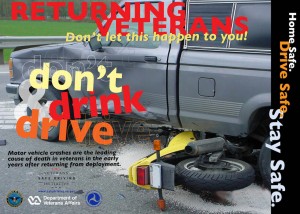11 – Returning Veterans and Traffic Safety: Once Home—Stay Safe, Drive Safe

January 15, 2014 | Posted in Podcast Episodes | By Traffic Safety Guy
Comments Off on 11 – Returning Veterans and Traffic Safety: Once Home—Stay Safe, Drive Safe
Podcast: Play in new window | Download
Subscribe: RSS
Motor vehicle crashes are a significant issue for the general population. But here in the U.S. it is even more so for those in the military. From 1999 through 2012, 4,423 active military personnel died in noncombat crashes versus the 4,409 of our soldiers killed in the Iraq war. Motor vehicle crashes are the leading cause of death for veterans in the early years after returning from deployment. In this episode Lieutenant Don Marose with the Minnesota State Police talks about why this is, and what is being done to reduce those numbers when our veterans return home.
Veterans and Re-Integration
Before deployment, many of our servicemen and women are trained on how to drive in a combat zone. The training is intensive and requires the building of “muscle memory,” when a person reacts automatically in certain situations. In a combat zone, they are trained to look for bombs lying alongside of the road or consider vehicles that approach them quickly as a threat. Driving “reckless” in Iraq and Afghanistan, running stop signs and weaving in and out of traffic, may be considered safe driving. When they return home, this driving would be considered aggressive and risky. Yet, that muscle memory is not something that can be turned off automatically.
Minnesota implemented a comprehensive re-integration program in 2005 to support the Minnesota National Guard veterans returning from deployment. The program included a discussion on traffic safety. The main point raised is that it will take time for the soldiers to feel comfortable and safe when driving. They need to understand that they were trained to react, and now they need to understand that this is a different environment requiring a different response—a less forceful response.
In his presentation, Lt. Marose speaks with the returning veterans on a wide variety of traffic safety topics, finishing up with the words that the veterans have put their lives “in harm’s way to defend our country. Our citizens cannot THANK YOU enough for your service. But don’t waste all of that by coming home to die in a stupid car crash!”
The program has spread to other states’ National Guard units and most of the branches of the U.S. Military.
Veterans and The Safe Driving Initiative
Also during this episode, the Traffic Safety Guy provides additional information on what the government is doing to support our veterans upon their return. In 2009, The Department of Veterans Affairs (VA), the Department of Transportation (DOT) and the Department of Defense (DOD) came together and developed the Veterans’ Safe Driving Initiative: Home Safe, Drive Safe, Stay Safe.
The Safe Driving Initiative was created with both short- and long-term considerations in mind. In the short-term, it includes a Public Health Information Campaign reaching out to the various veteran service organizations, state governors, law enforcement officials, and motor vehicle dealers and manufacturers. NASCAR legend and safe driving advocate Richard Petty is also a partner in the initiative. (See below PSA with Richard Petty.) Designed to increase a veteran’s awareness of motor vehicle risks, the focus is on:
- Impaired Driving Prevention (as a driver and as a passenger with an impaired driver)
- Wearing seat belts, and
- Wearing a helmet when riding a motorcycle
Additionally, the VA and the DOT developed a Veterans’ Traffic Safety Strategic Research Plan to look at the long-term answers, understanding that there are still a lot of questions that need answers; questions that include considerations of epidemiology, psychology, and biomechanics.
We have a long way to go to recognize the dedication of our service men and women, but this is a start—to make sure that once they are back home safe, they remain so on our nation’s roads.
Related Links:
Website:
Other:
- Article: Motor vehicle crashes: A little-known risk to returning veterans of Iraq and Afghanistan. The Washington Post: Health & Science. May 5, 2013.
- Article: Tragedy On Wheels: Why Returning Vets Are In Frequent Car Crashes. AOL Autos, October 11, 2011
- Traffic Safety Guy Blog: Veterans: Once Home—Stay Safe, Drive Safe
- Veterans Safe Driving Initiative Brochure
Richard Petty Video/PSA:
10 – Traffic Safety: A New Year; A New Direction

January 1, 2014 | Posted in Global Road Safety, Podcast Episodes | By Traffic Safety Guy
Comments Off on 10 – Traffic Safety: A New Year; A New Direction
Podcast: Play in new window | Download
Subscribe: RSS
A Conversation with Monika Samtani

Monika Samtani
Monika Samtani is an award-winning journalist, a business entrepreneur, and a mother of three. As a media professional for over 20 years, currently the traffic anchor on Washington, DC’s WUSA 9’s Morning News, and the host for a morning news transportation segment called the Extra Mile, Monika provides a unique perspective on traffic safety. She understands the importance for all of us to “just drive.”
Going the Extra Mile
While reporting traffic crashes from around the Washington D.C. metro area, Monika sees the significant impact poor choices can have on driving. Speaking with me between her traffic reports, Monika provides a glimpse into the world of reporting traffic crashes, and why she says, “Just drive.”
During her Extra Mile segment, Monika interviews traffic safety professionals on what can be done to be safer. Her interviews include speaking with Tim Hollister, Author and National Teen Driver Safety Advocate, and Kate Carr, CEO of Safe Kids Worldwide. A side-benefit of all that she has learned at work allows her to share it with her family, including her teenage son who is just learning to drive. Accused by her son of ‘knowing too much,’ Monika discusses what we all need to do to be safe drivers.
In her ‘free time,’ Monika is the President of Ms. Media, producing videos and providing public speaking training, and the founder of the Launch Network, a premiere networking organization connecting entrepreneurs and professional women in the U.S.
A New Direction

Is safety part of your New Year’s Resolutions?
Also during this episode, as the Traffic Safety Guy, I talk about the New Year and call on all of us to take a new direction for safety. For many, the New Year is a time of resolutions and individual efforts for self-improvement. Self–improvement should not be limited to our health. Did you know that:
- A 5% cut in average speed can result in 30% reduction in the number of fatal crashes.
- Not drinking and driving significantly reduces the risk of a traffic crash.
- Wearing a motorcycle helmet correctly can result in a 40% reduction to risk of death and 70% reduction of a serious injury.
- Wearing seat belts reduces the risk of a fatal injury by 50% for the front seat occupants and up to 75% for the rear seat passengers.
- Child restraints reduce the likelihood of a fatal crash 70% for infants and 54%-80% for young children.
What could be more about self-improvement than taking action to be a safer driver?
Many countries have strong national laws covering these specific issues, but the vast majority of countries acknowledge that more has to be done to enforce them. For a societal change, it takes awareness, understanding AND enforcement. Yet knowledge IS power, and each of us can make a difference; a difference in our own lives, and in the lives of those around us.
A New Year’s Resolution for Safety

What direction will your actions take you in 2014?
During this New Year, resolve to take a new direction in your life. Take this time to understand the importance of your actions. Recognize that each of us plays a role in saving lives. Use your expanding awareness and implement new behaviors to be a safer driver.
In this time of reflection of years past and contemplation of dreams to come, I wish you a very safe and joyous journey wherever life’s road takes you.
Happy New Year!
Related Links:
Websites:
Research:
Other:
- Highway to Safety Podcast, Episode 5 – Kate Carr
- Highway to Safety Podcast, Episode 6 – Tim Hollister
Videos
- Drive Sober or Get Pulled Over National Winter Crackdown – U.S. Transportation Secretary Anthony Foxx
- Drive Sober or Get Pulled Over National Winter Crackdown – NHTSA Administrator Strickland
- Drive Sober or Get Pulled Over National Winter Crackdown – MADD President Jan Withers



